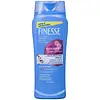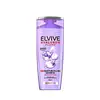What's inside
What's inside
 Key Ingredients
Key Ingredients

No key ingredients
 Benefits
Benefits

 Concerns
Concerns

 Ingredients Side-by-side
Ingredients Side-by-side

Water
Skin ConditioningSodium Lauryl Sulfate
CleansingSodium Laureth Sulfate
CleansingCocamidopropyl Betaine
CleansingDimethiconol
EmollientAmmonium Chloride
BufferingGlycerin
HumectantCocamide Mea
EmulsifyingParfum
MaskingCarbomer
Emulsion StabilisingAmodimethicone
C11-15 Pareth-7
EmulsifyingLaureth-9
EmulsifyingTrideceth-12
EmulsifyingGuar Hydroxypropyltrimonium Chloride
Skin ConditioningTetrasodium EDTA
Silk Powder
Skin ConditioningHydrolyzed Soy Protein
HumectantHydrolyzed Keratin
HumectantCamellia Japonica Seed Oil
EmollientPPG-9
Skin ConditioningPEG-45m
HumectantTea-Dodecylbenzenesulfonate
CleansingDMDM Hydantoin
PreservativeMethylchloroisothiazolinone
PreservativeMethylisothiazolinone
PreservativeMica
Cosmetic ColorantCI 77891
Cosmetic ColorantWater, Sodium Lauryl Sulfate, Sodium Laureth Sulfate, Cocamidopropyl Betaine, Dimethiconol, Ammonium Chloride, Glycerin, Cocamide Mea, Parfum, Carbomer, Amodimethicone, C11-15 Pareth-7, Laureth-9, Trideceth-12, Guar Hydroxypropyltrimonium Chloride, Tetrasodium EDTA, Silk Powder, Hydrolyzed Soy Protein, Hydrolyzed Keratin, Camellia Japonica Seed Oil, PPG-9, PEG-45m, Tea-Dodecylbenzenesulfonate, DMDM Hydantoin, Methylchloroisothiazolinone, Methylisothiazolinone, Mica, CI 77891
Water
Skin ConditioningSodium Laureth Sulfate
CleansingSodium Lauryl Sulfate
CleansingCocamidopropyl Betaine
CleansingSodium Chloride
MaskingGlycol Distearate
EmollientHexylene Glycol
EmulsifyingParfum
MaskingCocamide Mea
EmulsifyingCitric Acid
BufferingSodium Benzoate
MaskingSodium Hydroxide
BufferingDimethicone
EmollientCarbomer
Emulsion StabilisingCoco-Betaine
CleansingSalicylic Acid
MaskingGuar Hydroxypropyltrimonium Chloride
Skin ConditioningAmodimethicone
Trideceth-10
CleansingPEG-100 Stearate
Steareth-6
EmulsifyingSodium Hyaluronate
HumectantPhenoxyethanol
PreservativeLimonene
PerfumingTrideceth-3
EmulsifyingFumaric Acid
BufferingAcetic Acid
BufferingCI 60730
Cosmetic ColorantCI 60725
Cosmetic ColorantWater, Sodium Laureth Sulfate, Sodium Lauryl Sulfate, Cocamidopropyl Betaine, Sodium Chloride, Glycol Distearate, Hexylene Glycol, Parfum, Cocamide Mea, Citric Acid, Sodium Benzoate, Sodium Hydroxide, Dimethicone, Carbomer, Coco-Betaine, Salicylic Acid, Guar Hydroxypropyltrimonium Chloride, Amodimethicone, Trideceth-10, PEG-100 Stearate, Steareth-6, Sodium Hyaluronate, Phenoxyethanol, Limonene, Trideceth-3, Fumaric Acid, Acetic Acid, CI 60730, CI 60725
 Reviews
Reviews

Ingredients Explained
These ingredients are found in both products.
Ingredients higher up in an ingredient list are typically present in a larger amount.
This water-soluble silicone is used for its hydrating and softening properties. It is used to add a silky feel to skincare products and has great benefits for haircare.
In haircare, this ingredient:
- Adds shine
- Protects color
- Offers thermal protection
- Boosts hair strength
- Does not build up as easily
Carbomer is a polymer of acrylic acid. Its main role is to create a gel consistency.
A high amount of carbomer can cause pilling or balling up of products. Don't worry, most products contain 1% or less of carbomer.
We don't have a description for Cocamide Mea yet.
Cocamidopropyl Betaine is a fatty acid created by mixing similar compounds in coconut oil and dimethylaminopropylamine, a compound with two amino groups.
This ingredient is a surfactant and cleanser. It helps gather the dirt, pollutants, and other impurities in your skin to be washed away. It also helps thicken a product and make the texture more creamy.
Being created from coconut oil means Cocamidopropyl Betaine is hydrating for the skin.
While Cocamidopropyl Betaine was believed to be an allergen, a study from 2012 disproved this. It found two compounds in unpure Cocamidopropyl Betaine to be the irritants: aminoamide and 3-dimethylaminopropylamine. High-grade and pure Cocamidopropyl Betaine did not induce allergic reactions during this study.
Learn more about Cocamidopropyl BetaineThis ingredient is derived from guar gum.
It is a conditioning ingredient, meaning it helps soften skin and hair.
Parfum is a catch-all term for an ingredient or more that is used to give a scent to products.
Also called "fragrance", this ingredient can be a blend of hundreds of chemicals or plant oils. This means every product with "fragrance" or "parfum" in the ingredients list is a different mixture.
For instance, Habanolide is a proprietary trade name for a specific aroma chemical. When used as a fragrance ingredient in cosmetics, most aroma chemicals fall under the broad labeling category of “FRAGRANCE” or “PARFUM” according to EU and US regulations.
The term 'parfum' or 'fragrance' is not regulated in many countries. In many cases, it is up to the brand to define this term.
For instance, many brands choose to label themselves as "fragrance-free" because they are not using synthetic fragrances. However, their products may still contain ingredients such as essential oils that are considered a fragrance by INCI standards.
One example is Calendula flower extract. Calendula is an essential oil that still imparts a scent or 'fragrance'.
Depending on the blend, the ingredients in the mixture can cause allergies and sensitivities on the skin. Some ingredients that are known EU allergens include linalool and citronellol.
Parfum can also be used to mask or cover an unpleasant scent.
The bottom line is: not all fragrances/parfum/ingredients are created equally. If you are worried about fragrances, we recommend taking a closer look at an ingredient. And of course, we always recommend speaking with a professional.
Learn more about ParfumSodium Laureth Sulfate (SLES) is a foaming, cleansing, and emulsifying ingredient. It is created from palm kernel oil or coconut oil. SLES is not the same as sodium lauryl sulfate. It is much milder and less likely to irritate.
SLES helps create foam in personal products. It also prevents ingredients from separating, helping to elongate the shelf life.
Sodium Laureth Sulfate is a type of sulfate. It can be drying. We recommend speaking with a professional about using this ingredient if you have concerns.
Learn more about Sodium Laureth SulfateSodium Lauryl Sulfate (SLS) is a sulfate with surfactant properties.
The surfactant property make it a great foam creator and cleansing agent. Surfactants help bind ingredients that normally do not mix.
Some studies have shown skin irritation due to prolonged SLS use.
Sodium Laureth Sulfate (SLES) is a milder version of SLS.
Learn more about Sodium Lauryl SulfateWater. It's the most common cosmetic ingredient of all. You'll usually see it at the top of ingredient lists, meaning that it makes up the largest part of the product.
So why is it so popular? Water most often acts as a solvent - this means that it helps dissolve other ingredients into the formulation.
You'll also recognize water as that liquid we all need to stay alive. If you see this, drink a glass of water. Stay hydrated!
Learn more about Water